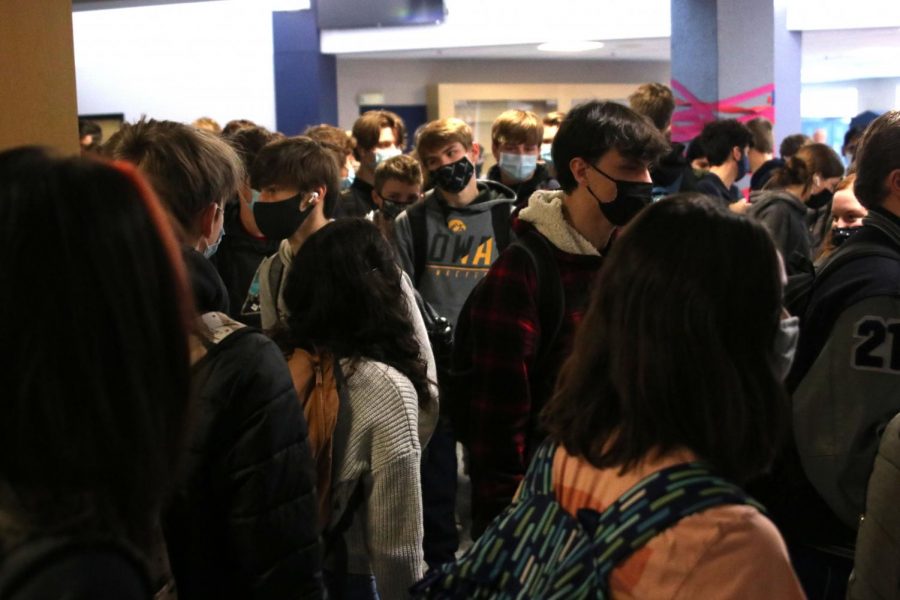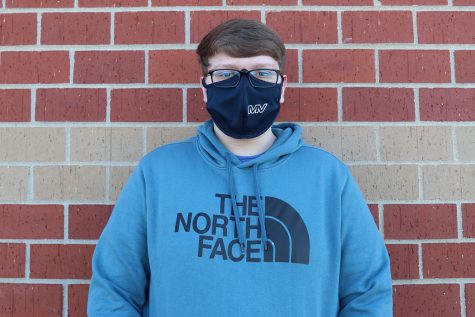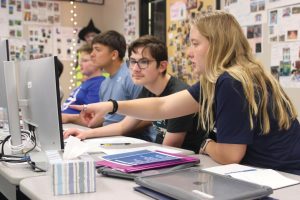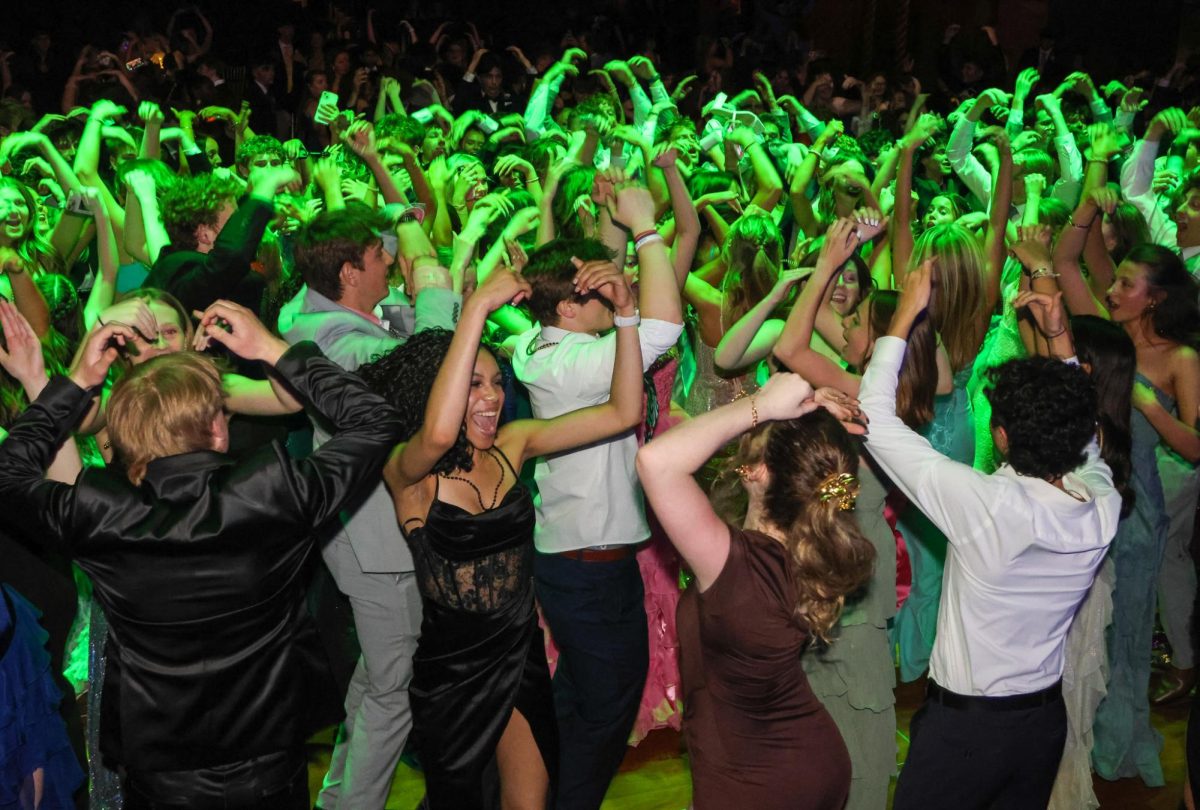The return to fully in-person learning came too soon
The school board’s baffling decision to send students back to a fully in-person learning model creates more issues than it solves
February 13, 2021
Amongst a time of great uncertainties, one thing is for certain: now is not the time to return to a fully in-person learning model. While there are some benefits to it, these are greatly outweighed by the risks and challenges that come with cramming over 1200 students in the same building every day of the week.
The COVID-19 pandemic is far from over. While the number of new cases in Johnson County is falling, COVID-19 is still a major concern. If everything opens back up every time the numbers even show signs of falling, the numbers are bound to rebound, causing the process to repeat itself. As of writing this, three people in Johnson County have died from the virus alone today. It is still an issue that needs to be taken as seriously as possible in order to protect everyone’s well-being.
One of the most common arguments supporting the return to fully in-person learning is that schools are not a primary source of spread. However, data that suggests this is more often than not pulled from areas that have not been hit as hard by the COVID-19 pandemic. With this virus being so new, little conclusive research has been conducted, and oftentimes scientists disagree on the validity of findings. The general consensus, however, is that it depends on location. According to a study of national COVID-19 data, an area with a large amount of positive COVID-19 cases is very likely to have spread in schools, and an area with a lower amount is less likely to have spread in schools.
Uncertainty is a surefire sign that it is not safe to open. For example, many school districts opened back up fully after summer break. During the summer, cases fell, and it seemed to be safe. However, when schools opened back up in these areas, cases went back up and districts started to backpedal on their decisions. It is this attitude of recklessness that leads to the virus sprouting back up time and time again, ruining any real progress.
Even if the standard strain of COVID-19 wasn’t especially dangerous like some individuals claim, new mutations of the original virus are raising concerns worldwide. Just like any other living organisms, viruses mutate and evolve to become more efficient and survive more effectively. What that means for humans is that the virus is bound to mutate and adapt to a large portion of the solutions that are put in place, and will become much more infectious and deadly.
A prime example of this is the strain of COVID-19 that has recently appeared in the UK, a SARS-CoV-2 variant B.1.1.7, better known as the UK strain. This strain of the virus has mutated to become much more infectious than before. While it may not be more deadly than the original strain (evidence on that is unclear), if it is to spread and infect more people, that means more people are going to be hospitalized, and more will die. This strain is already in multiple parts of the U.S. within people who have no recent history of travel, suggesting that it is silently spreading as time goes on due to the virus’ long incubation period.
The main point here is that while schools may not be the dominant source of infections, those infections still happen, and a new, stronger variant (whether it exists yet or not) could be more equipped to spread faster and more efficiently in schools. The fact alone that there is so much uncertainty about new virus strains and how they might spread in schools is enough to justify shutting down schools now so they have less of a chance to spread and harm more people.
All this said, remote learning and hybrid learning models do have especially notable downsides. When students are split in half on top of having a block schedule, it can get complicated for teachers to assign work with appropriate due dates that keep it fair for all students. Perhaps the biggest caveat is that it is harder for teachers to connect with students when they only see them one or two times a week.
The most visible outcry against hybrid and remote models is that it creates a notable drop in students’ grades that is created by this disconnect between teachers and students. After all, students and teachers connect face to face a maximum of half the normal amount within hybrid learning, and have no face to face contact during the fully remote learning model. However, I’ll propose a different idea: if a student is getting bad grades in a different learning model, the student is to blame, not their location.
Within hybrid and remote learning, there is ample opportunity for students and teachers to connect. With the way seminar has been set up this year so far, it is easier and simpler than ever to meet up with a teacher. With the click of a zoom link, students can be talking live with a teacher in a matter of seconds and get help on something they’re stuck on or not understanding, all from the comfort of their home (or seminar classroom within hybrid). And with how technology has been utilized in schools during this pandemic, teachers are bound to check their emails for questions much more often than previous years.
If all this is true, then why are grades dropping? Well, when at home, students have more distractions around them, and are more prone to use their phones, eat, sleep, play video games and the like during class. At the end of the day, that is the fault of the student and doesn’t reflect teachers’ ability to teach, or the overall retention capabilities of learning under a fully remote model. They are actively making decisions that will make it hard for them to test well and succeed in class.
In almost every class I have attended online, there have been multiple students who refuse to even turn on their camera, and even more who are on their phones, playing video games, or flat out sleeping during class. There is absolutely no way for teachers to limit these decisions other than by creating participation point systems, which only adds anxiety for students that are trying to learn. It is time to accept that students have the distinct choice to either pay attention and succeed, or disregard their online classes. When students choose the latter, they have no one to blame but themselves for failing.
The return to normalcy is far from absolute. It’s obvious that if schools fully open back up they have to take safety precautions to keep everyone safe. But this begs a few questions about what is effective and what isn’t. Why is it that students have to squeeze through a single doorway close enough to be rubbing against one another, only to eat lunch alone and facing a wall? Why are students not allowed to visit teachers they need help from (the whole point of returning to school full time!), only to have every single student in the entire school shove their ways through crowded hallways to get from one class to another only minutes later? Why are seating charts mandatory for contact tracing when there are multiple times a day that every student is shoulder-to-shoulder with one another in the hallway?
The solution to these problems is not more rules and restrictions. No matter what precautions are taken, students will always have that constant fear of contracting the virus through some unseen contact since the school is so crowded. It is already dreadful enough to be subjected to mind-boggling rules that make being at school feel as if you’re constantly being punished, and coupled with the stress and anxiety that come with never knowing if you’re safe, the decision to return can eventually have just as serious repercussions on the mental health of students as staying home.
In the end, there is no solution that will make everyone happy. But making everyone happy is not what’s important in this situation. You can put whatever modifiers you want onto a graph to show statistics in the green zone. You can pretend like you’re able to trace the contacts of students from weeks ago to alert students at risk. You can make every student eat lunch alone. But one truth remains: We are not safe as long as everyone is in school until a vaccine is widespread. It is time to stop listening to the loud minority in favor of prioritizing the safety of students, and the lives of their families and teachers.














Donna Syed • Feb 15, 2021 at 12:03 pm
BRAVO! Every school’s newspaper should reprint this article.
Angi Verstraete • Feb 15, 2021 at 8:44 am
Fantastic read. Thank you. From a USD 233 High School teacher.
Gretchen Doyle • Feb 14, 2021 at 2:36 pm
Very well written article! Great to see someone else (especially a student) who understands science and public health.
Gabby Delpleash • Feb 14, 2021 at 1:14 pm
This article is absolutely remarkable! Thoroughly researched with concise and well-crafted arguments that concur with what many students and teachers have been saying since Day 1.
Susan Massy • Feb 14, 2021 at 11:58 am
Outstanding, well-researched, well-considered editorial! I hope it goes viral!